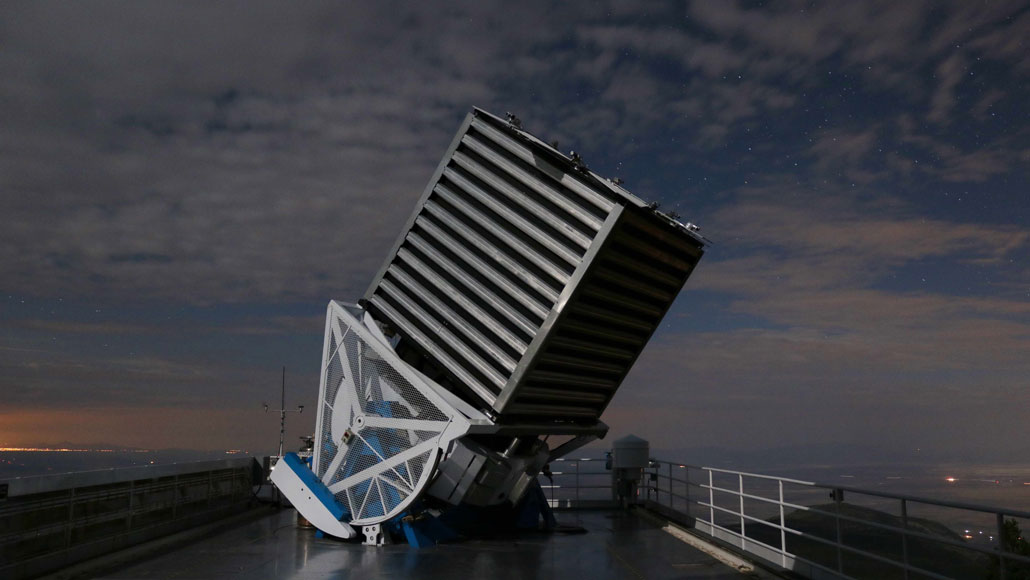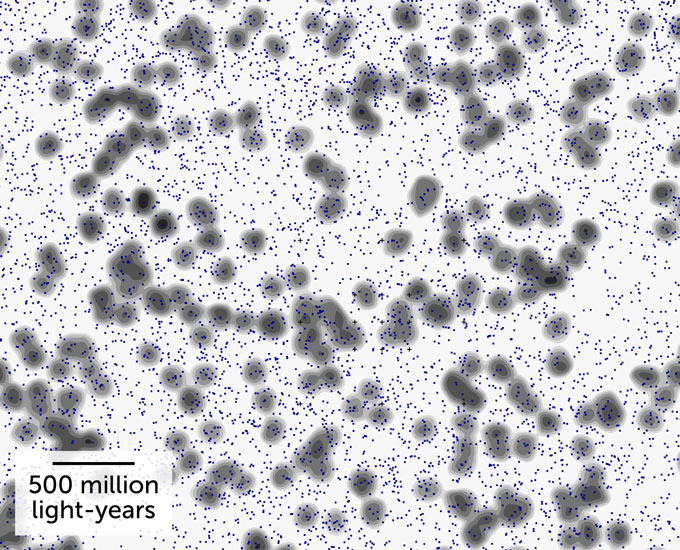Huge arc of galaxies is surprising and puzzling cosmologists
If real, this 3-billion-light-year-long discovery would be a 'big deal'

Observations of thousands of galaxies taken by the Sloan Digital Sky Survey system (pictured) helped reveal what seems to be a giant arc of galaxies. That arc is more than 3 billion light-years long.
Patrick Gaulme/Sloan Digital Sky Survey (CC BY 4.0)
A long string of galaxies appears to form an arc stretching more than 3 billion light-years across the distant universe. If the arc turns out to be real, it would challenge a basic idea about how the cosmos is structured. It’s known as the “cosmological principle.” And it holds that no matter where you look in the universe, on large scales matter will be distributed fairly evenly.
If it now turns out that this is not true — as the newfound arc suggests — “it would overturn cosmology as we know it,” said Alexia Lopez on June 7. She spoke at a news conference at a virtual meeting of the American Astronomical Society. It would mean, she said, that “our standard model, not to put it too heavily, kind of falls through.”
As a cosmologist, Lopez studies the origins and evolution of the universe. She works at the University of Central Lancashire in Preston, England. She was part of a team that discovered the distant structure. They call it simply the Giant Arc.

The arc turned up as the researchers were studying images captured as part of the Sloan Digital Sky Survey. That survey, which covers about one-third of the sky, includes the most detailed three-dimensional maps of our universe. It includes light spectra for more than three million astronomical objects.
Lopez’s team focused on light from some 40,000 quasars. These are the glowing cores of giant galaxies. Yet they are so distant they appear as mere points of light. On its way to Earth, some of that light gets absorbed by atoms in and around galaxies nearer to us. This absorption creates a signature change in the light that eventually reaches telescopes on Earth or in space.
The Giant Arc’s signature is due to magnesium atoms. Each has lost one electron. They’re glowing in the halos of galaxies about 9.2 billion light-years away. Quasar light absorbed by those atoms traces out a nearly symmetrical curve. That curve contains dozens of galaxies. Lopez reports that together they span about one-fifteenth the radius of the observable universe.
That arc is invisible to the human eye. But if you could see it from Earth, it would span about 20 times the width of the full moon.
The arc as cosmic dilemma
The problem is that this arc makes part of the sky seem too organized. The galaxies are not as evenly distributed as astronomers have always thought they should be.
As such, this finding “is a very fundamental test of the hypothesis that the universe is homogeneous on large scales,” says Subir Sarkar. He’s an astrophysicist at the University of Oxford in England. Although he studies large-scale structures in the cosmos, he did not take part in the new work. If the Giant Arc is real, he says, “this is a very big deal.”
But not all researchers are convinced the arc is real. “Our eye has a tendency to pick up patterns,” Sarkar notes. For instance, he points out that some people have claimed to see Stephen Hawking’s initials written in fluctuations of the background cosmic microwave radiation. This is the oldest light in the universe.
Lopez ran three mathematical tests to figure out the odds that galaxies would line up in a giant arc just by chance. All three suggest that the structure is real. One test surpassed physicists’ gold standard that the odds of it being a statistical fluke should be less than 0.00003 percent.
That sounds pretty good, but it may not be good enough, Sarkar says. “Right now,” he says, “I would say the evidence is tantalizing, but not yet compelling.”
More observations may be needed to firmly support or refute the presence of a Giant Arc.
But if the Giant Arc is real, it would join a growing group of large-scale structures in the universe that, when taken together, break the standard model of cosmology. This model assumes that when you look at large enough volumes of space — above about 1 billion light-years across — matter will map out evenly. The Giant Arc, however, appears about three times as long as that threshold.
And it’s not the only such seeming anomaly. There are a number of other large structures in the sky. These include the Sloan Great Wall, the Giant Gamma-Ray Burst Ring and the Huge Large Quasar Group.
With one large-scale structure, “that could just be a statistical fluke,” Lopez says. “That’s not the problem. All of [those big structures] combined is what makes the problem even bigger.”







